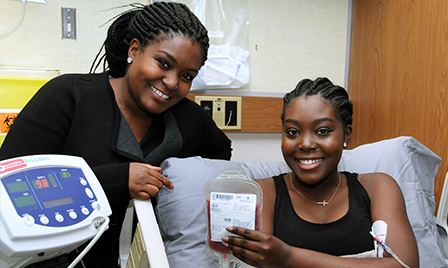
May 14, 2018
Story by Greg Harris | Photo by Paul Rotzinger
CALGARY — Revée Agyepong of Edmonton is looking forward to trying her hand at a few things that others take for granted, such as sports — and even letting herself get a little bit dehydrated in the process.
As someone who has lived her entire life with sickle cell disease, the 26-year-old has had to take care to drink lots of water, or risk touching off a sickle cell crisis that might lead to the emergency department.
She‘s one of the first adult patients in Canada to be successfully treated for sickle-cell disease with transplanted stem cells.
“I’m still not sure if I fully believe it,” she says. “My whole life has revolved around sickle cells and now I feel like a new person. I’m so blessed.”

Sickle cell patient Revée Agyepong, right, poses just prior to her transplant of donated stem cells from her sister Stephanie Amoah.
Agyepong underwent the procedure at Calgary’s Tom Baker Cancer Centre late last year with donor cells from her older sister, Stephanie Amoah. Today, Agyepong’s blood tests confirm she is essentially cured.
Sickle-cell disease is an inherited disorder in which blood cells change into a semi-circular ‘sickle’ shape and block blood vessels. It varies in severity from patient to patient but every organ is potentially at risk. In Agyepong’s case, she has experienced chronic bone and joint pain, irregular heartbeat, kidney stones and shortness of breath. She has had her gall bladder removed and her spleen no longer functions.
To manage her illness, she has been on several medications and, for the past several years, has undergone a red blood cell exchange every eight weeks. The exchange is a three-hour transfusion process in which two litres of donor blood is exchanged to reduce the amount of sickle cells she has. Despite these efforts, she wound up in the emergency department five times in the seven months leading up to her transplant.
Dr. Andrew Daly, who leads Alberta’s bone marrow transplant program which operates out of the Tom Baker Cancer Centre, oversaw Agyepong’s stem cell transplant.
“When Revée approached us, we had coincidentally been thinking about adult stem cell transplant for sickle cell disease, based on the remarkably good outcomes that Alberta Children’s Hospital has been seeing with transplants in the pediatric population,” says Dr. Daly.
“She met all the necessary criteria in terms of being able to tolerate a transplant but, most important, she had a sibling who was a 100 per cent match.”
Agyepong’s sister Stephanie Amoah initially spearheaded the idea of trying to arrange a stem cell transplant for her.
“Every day we’d find out something new was breaking down. It hurt me to see her in crisis and pain with no way out of it,” Amoah says. “Being a donor was a no-brainer. I knew that if I was a match, I was definitely going to be the donor.”
In general, the older the patient and donor in a bone-marrow transplant, the greater the risk of graft versus host disease (GVHD), a type of immune system rejection that can cause serious problems, even death.
Dr. Bruce Ritchie, Agyepong’s longtime hematologist in Edmonton, says he cautioned his patient about the transplant “but Revée’s determination convinced me and the rest of the group to reassess our approach.”
Today, he hails the transplant as a breakthrough for adult sickle-cell patients.
“This is great news and has led to a big change in how we practice. We are now trying to move ahead with transplants for other suitable patients with matched sibling donors,” Dr. Ritchie says.
The transplant involved a number of different steps. Agyepong was given medication to suppress her immune system, as well as a low dose of radiation. Meanwhile, Agyepong’s sister underwent a process called apheresis that collected her sickle-cell-free stem cells, which were subsequently given to Revée.
Dr. Daly says one of the risk-reducing improvements in the process is that the medications used in the preparation phase are immuno-suppressive, but not as intense as the chemotherapy agents typically used for cancer patients undergoing similar bone marrow transplants.
“Revée’s story shows how Alberta’s public healthcare system is leading the way in fostering innovation and improvement,” says Health Minister Sarah Hoffman. “This is an incredible example of patients, families and health professionals working together to make lives better.”
Agyepong chose nursing as a career in large part because of the care she has received throughout her life. She has worked in the neonatal intensive care unit at Stollery Children’s Hospital in Edmonton, as well as the Rare Blood Disorders Clinic at the Kaye Edmonton Clinic.
“Nurses have been the ones who made the most difference when I’ve been in hospitals,” she says. “And now that I’ve had this experience as a transplant patient, I’ll be able to bring that perspective as another way of giving back.”